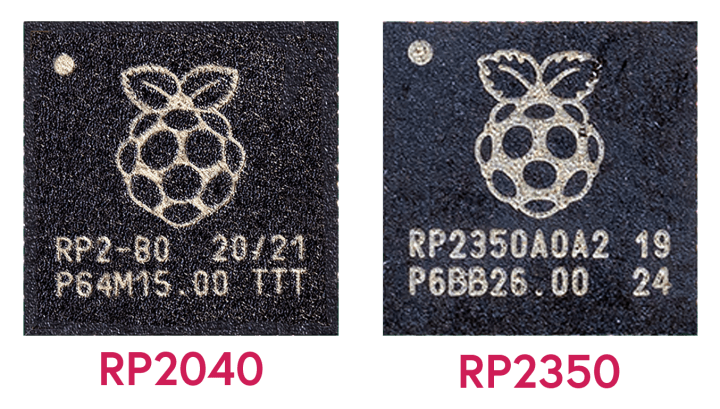Raspberry Pi Pico 2: A Powerful New Addition to the Microcontroller Family
on
In the embedded arena, the Raspberry Pi Pico series has been a standout for its balance of performance, cost, and versatility since 2021. Now, Raspberry Pi has upped the ante with the release of the Raspberry Pi Pico 2. This new model promises significant enhancements that will excite both hobbyists and professional developers alike.
What's New in the Raspberry Pi Pico 2?
The Raspberry Pi Pico 2 is built on the brand-new RP2350A microcontroller, bringing a range of improvements. Let’s compare both the new board with the old board, and the new RP2350 silicon with the RP2040.

The Boards: Raspberry Pi Pico 2 vs Raspberry Pi Pico
- Higher Clock Speed: The Pico 2 features a system clock speed of 150 MHz, compared to the original Pico's 133 MHz. This increase alone provides an incremental boost in performance for computationally intensive tasks.
- Increased Flash Memory: The Pico 2 includes 4 MB of on-board QSPI flash memory, doubling the 2 MB found on the original Pico. This expansion allows for larger and more complex applications.
- Enhanced Interfacing: While both boards feature 26 multipurpose GPIO pins, the Pico 2 includes additional capabilities such as support for 4 ADC pins and an upgraded USB 1.1 controller with additional security features for peripheral and memory protection.
- Improved Power Efficiency: The new Pico 2 is designed to be more power-efficient, making it better-suited for battery-operated projects.
- Compatibility: Despite these upgrades, the Pico 2 retains compatibility with the hardware and software ecosystem of the original Pico, ensuring a seamless transition for users. This compatibility is certain to raise a small gripe with certain users: “Why no USB-C?” It comes down to whether you want 100% mechanical compatibility or not. I would like a nice, shiny new USB-C connector on the board, but then again, there are many enclosures available for the original Raspberry Pi Pico that are built around the Micro USB connector.

| Raspberry Pi Pico 2 | ||
|---|---|---|
| System Clock Speed | 133 MHz | 150 MHz |
| On-board Flash Memory | 2 MB QSPI | 4 MB QSPI |
| GPIO Pins | 26 | 26 (4× ADC capable) |
| USB | USB 1.1 host/device | Upgraded USB 1.1 host/device with additional security features for peripheral and memory protection. (Still the same old Micro USB connector) |
| Power Efficiency | Standard | Improved |
The Chips: RP2350 vs RP2040
At the hearts of these boards are their respective microcontroller chips, the RP2040 and the new RP2350, each bringing unique features and advancements:
- Core Architecture: The RP2040 features dual Arm Cortex-M0+ cores, while the RP2350 offers a choice between dual Arm Cortex-M33 cores or dual RISC-V Hazard3 cores. One might think that this means having to select the appropriate hardware version, but in fact the selection is done in software during the development phase. This gives the RP2350 a significant edge in terms of processing power and flexibility.
- Clock Speed: The RP2040 runs at a maximum clock speed of 133 MHz, whereas the RP2350 can operate at 150 MHz, offering improved performance for demanding tasks.
- Memory: The RP2040 has 264 KB of on-chip SRAM, while the RP2350 takes this to 520 KB. The increased memory capacity allows for more complex applications and better multitasking capabilities.
- Security: One of the major advancements in the RP2350 is its comprehensive security architecture, which includes Arm TrustZone, signed boot, 8 KB of antifuse OTP for key storage, SHA-256 acceleration, and fast glitch detectors. These features provide a robust security framework, which is not present in the RP2040.
- Peripheral Interface: The RP2040 includes support for two UARTs, two SPI controllers, two I²C controllers, ADC, PWM, and USB 1.1. The RP2350 enhances these capabilities with additional PIO state machines, more GPIO pins (up to 48), and improved power efficiency through a switch-mode DC-DC converter.

| RP2040 | RP2350 | |
|---|---|---|
| Core Architecture | Dual Arm Cortex-M0+ | Dual Arm Cortex-M33 or Dual RISC-V Hazard3 (selectable during development) |
| Maximum Clock Speed | 133 MHz | 150 MHz |
| On-chip SRAM | 264 KB | 520 KB |
| Security | Basic security features | Arm TrustZone, signed boot, SHA-256, TRNG, glitch detectors |
| Peripheral Interfaces | 2× UART, 2× SPI, 2× I²C, ADC, PWM, USB 1.1 | Enhanced peripherals, additional PIO state machines, more GPIO pins (depending on chip package), improved power efficiency |
Availability
The Raspberry Pi Pico 2 is available for pre-order in the Elektor Store now!
The Raspberry Pi Pico 2 is a great addition to the Pico segment, offering enhanced performance, greater security, and versatile interfacing while maintaining the affordability that the Pico series is known for. It's an excellent choice for anyone looking to take their projects to the next level.
As always, we want to know what you will do with this! Let us know in the comments below.









Discussion (2 comments)